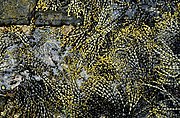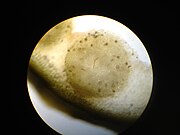|
Hormosira
Hormosira is a genus of seaweed in the family Hormosiraceae. It is monotypic, with a single species, Hormosira banksii, also known as Neptune's necklace, Neptune's pearls, sea grapes, or bubbleweed[2] it is native to Australia and New Zealand.[1][3] DistributionHormosira is native to southeastern Australia (including Tasmania, Lord Howe Island and Norfolk Island) and New Zealand.[1][2][3][4][5][6][7] Despite substantial morphological variation across its range, the species represents a single species and the genus Hormosira is monotypic.[5] Genetic analyses of mitochondrial COI and microsatellite DNA sequence data have indicated that there is low genetic variation across the range of the species in Australia.[5][6] DescriptionHormosira is a perennial[4] species of seaweed (brown algae, Fucales).[3] It is abundant on low-energy rocky reefs within the intertidal zone, where it outcompetes other algal species due to its high tolerance to desiccation. Plants vary significantly in morphology.[5] The thallus (or frond) of the species is made up of strings of olive-brown, spherical, gas-filled pneumatocysts (or beads), which taper towards a small holdfast.[2] While the holdfast attaches strongly to a substrate, it can be easily dislodged by human trampling.[4] The spheres are buoyant and rise to the surface of the water during high tide, allowing plants to move with the flow of the current and obtain more sunlight.[8] Hormosira also produces a slime layer to reduce desiccation,[8] and plants often grows in high densities,[4][7] which reduces their surface area exposed to the sun and further reduce dehydration.[8] Due to the buoyant thallus, Hormosira plants can drift out to sea over considerable distances, and floating plants can remain fertile for several weeks.[5] Hormosira seaweed
ReproductionHormosira reproduces sexually and is monoecious. The sex organs (conceptacles) are on the surface of the beads, and are visible to the naked eye as rough-looking dimples.[9] Hormosira produces eggs throughout the year, but its peak reproduction is often confined to July–October (at least in northern New Zealand) when the sea temperature is around 14 °C, as the viability of the eggs can be low in high sea temperatures such as 17–22 °C.[10] At high tide, the eggs are released directly into the surrounding water. The eggs are negatively buoyant they sink to the substrate to develop for several days before becoming attached.[5] All individuals release at the same time, maximising fertilisation. The species can also reproduce asexually from broken and dislodged fragments. Hormosira reproduction
Ecology Hormosira is regarded as an ecosystem engineer[6] or habitat former[7] that occurs in large patches and outcompetes other algal species due to its high tolerance to desiccation. Hormosira is a food source for sea urchins, many small crustaceans, and some juvenile fish.[8] Young crustaceans and molluscs often rely on the dense canopies of Hormosira for niche space, protection from predators, and avoid desiccation at low tide.[8] Hormosira provides a substrate for sessile organisms to attach onto, including sea urchins and a wide range of facultative and obligate algal epiphytes such as Notheia anomala.[7] This is beneficial to many organisms as competition for habitat space is a primary limiting factor in the intertidal environment. UsesDue to the species' high iodine content, Tasmanian schoolchildren were once urged to eat a bead a day to keep the goitres away.[11] References
External links
|
||||||||||||||||||||||||||||||||||
Portal di Ensiklopedia Dunia






